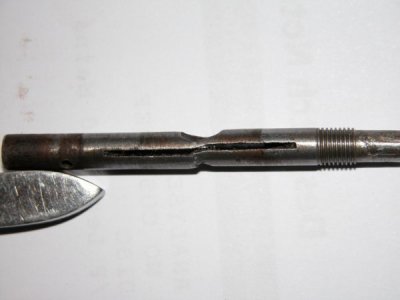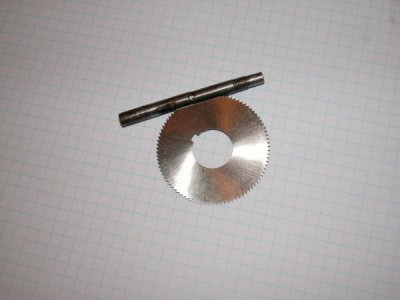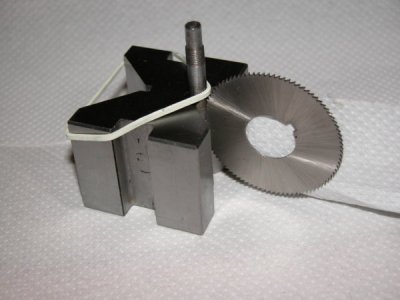- Joined
- May 27, 2016
- Messages
- 3,469
I want to make a replacement shaft for a carburettor butterfly valve.
The original got damaged with a "twist" during the effort to to extract it from the carburettor body, because it was so seized up by some corrosion. The engine is from a real vintage aircraft - so much regrets. I have a scheme, perhaps not too clever, but that is why I am asking here on the right way to go about this.
The pictures tell it all. The need is to saw a slit from each side to create the slot for the round butterfly valve disc to slide into, secured by a countersunk screw across the shaft. The saw I found is 1.75 inch diameter, HSS hollow ground, 1/32" teeth x 90 of them, and it seems to just about jam into the slot, and seems to match the original slot just right. It has a 5/8" hole in the saw for the arbour.
The end of the tweezer in the picture is just to stop it rolling away onto the floor. Picture taking here was a comedy!
The butterfly shaft measures about 0.217", probably to fit through a 7/32" hole (0.2188").
I do not have a mill, nor access to one, but I do have a South Bend 9C lathe (as relative beginner!)
My thought was to try and mount the saw on a rod between the chuck and a tail-stock centre, or even between centres, kind of creating my own 5/8" shaft mill. Then to contrive some way of supporting the (new) shaft onto the cross-slide. OK - rubber elastic bands are not involved, and I already took some teasing, but the idea is there. Is this the way to do it?
How does one hold a shaft secure in place for a cut like this, even on a mill?
There are incidental questions - like how to make up an arbour shaft to turn the saw.
I would, of course, like to try and use my lathe. Is the plan unrealistic?
All advice is welcome, even if it is to find and pay a mill machinist!


 I
I
The original got damaged with a "twist" during the effort to to extract it from the carburettor body, because it was so seized up by some corrosion. The engine is from a real vintage aircraft - so much regrets. I have a scheme, perhaps not too clever, but that is why I am asking here on the right way to go about this.
The pictures tell it all. The need is to saw a slit from each side to create the slot for the round butterfly valve disc to slide into, secured by a countersunk screw across the shaft. The saw I found is 1.75 inch diameter, HSS hollow ground, 1/32" teeth x 90 of them, and it seems to just about jam into the slot, and seems to match the original slot just right. It has a 5/8" hole in the saw for the arbour.
The end of the tweezer in the picture is just to stop it rolling away onto the floor. Picture taking here was a comedy!
The butterfly shaft measures about 0.217", probably to fit through a 7/32" hole (0.2188").
I do not have a mill, nor access to one, but I do have a South Bend 9C lathe (as relative beginner!)
My thought was to try and mount the saw on a rod between the chuck and a tail-stock centre, or even between centres, kind of creating my own 5/8" shaft mill. Then to contrive some way of supporting the (new) shaft onto the cross-slide. OK - rubber elastic bands are not involved, and I already took some teasing, but the idea is there. Is this the way to do it?
How does one hold a shaft secure in place for a cut like this, even on a mill?
There are incidental questions - like how to make up an arbour shaft to turn the saw.
I would, of course, like to try and use my lathe. Is the plan unrealistic?
All advice is welcome, even if it is to find and pay a mill machinist!


 I
I
Last edited:

